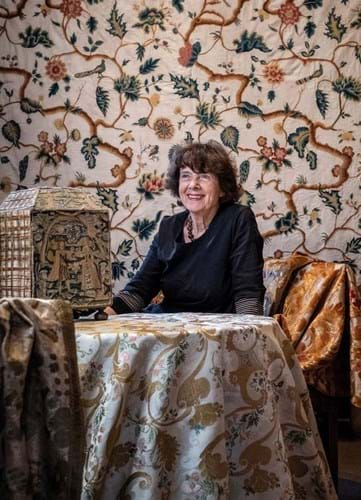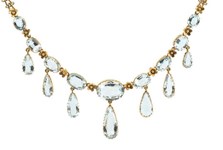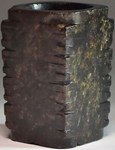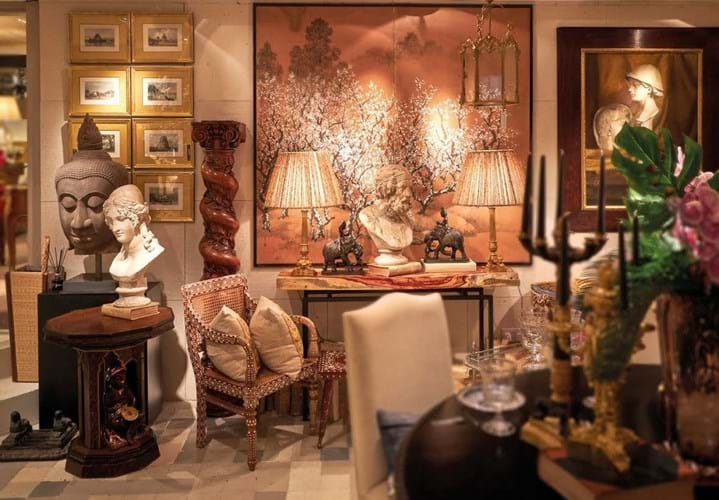
Some of the contents of Guinevere Antiques going under the hammer at Dreweatts on May 23. The dealership is leaving its Kings Road shop after 60 years. Dreweatts is also holding a sale on April 25-26 for Windsor House Antiques. It is the second of two auctions as the firm leaves Barnwell Manor, its home of 24 years.
For the Derbyshire oak specialist Paul Beedham, it was the rising cost of storage space that paved the way to holding an auction.
Heading off the effects of a rent increase, at the end of last year Beedham cut the floor space of his 3000 sq ft warehouse unit in half and built a mezzanine over the remaining part, During the reorganisation, he thinned his stock and family collection, finding 150 pieces to place with Bishop & Miller of Stowmarket for The Beedham Collection auction of March 29.
Choosing what to part with “was incredibly difficult”, he says.
Often the decision was down to size. One of the top performing lots, a mid-17th century six-leg oak refectory table from North Lancashire, was too big to be stored in the units he uses within the warehouse. Bed frames and panelling can be easily kept along walls, but the loss of wall space made those obvious candidates for sale too.
But there were also less-tangible criteria to consider. Around 80% of the offerings were from the family collection, some of which he remembers buying with his father. “You have the love and passion for the collection”, Beedham says, “We always bought with a collector’s eye. It was very personal.”
The right mix
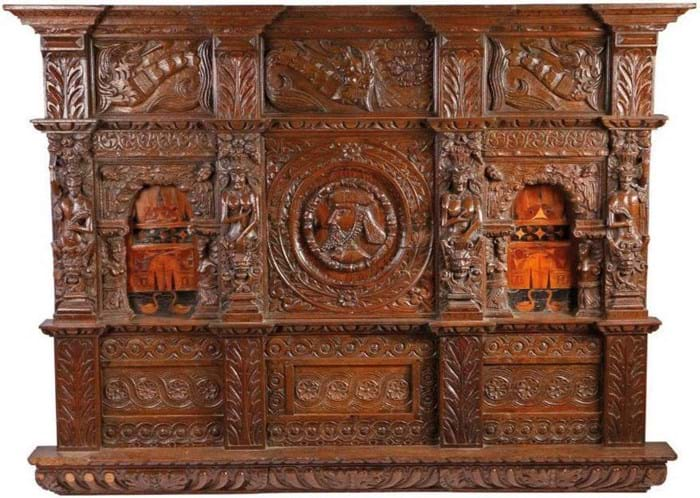
An oak and inlaid overmantel, c.1580, from Prinknash Abbey, which took £20,500 at Bishop & Miller’s sale of The Beedham Collection on March 29.
There is unquestionably an art to curating a sale. In order to appeal to the widest possible crowd, Beedham mixed five-figure estimates with lower value lots, making sure that the pieces had the rarity and quality central to the firm’s history.
Even for seasoned dealers, however, the open market can be difficult to predict. Most dealer sales bring moments of both pleasure and pain.
The refectory table, for example was hammered down for £18,000 but was worth closer to £40,000, Beedham says. Meanwhile an Elizabethan oak and inlaid overmantel from Prinknash Abbey closed at £20,500, which he judges to be just about market value, while a 12th century Romanesque bear carving stunned, taking £13,000 over a high estimate of £3000.
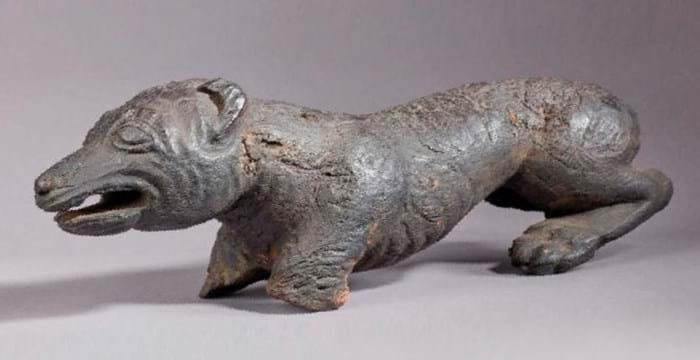
An Anglo-French 12th century Romanesque carved oak bear that was hammered down for £13,000.
“It seems generally objects are very strong”, Beedham added. “It’s easier to house smaller items.”
Furniture was trickier. Several coffers made strong prices, but the two beds that were put in the sale failed to get away – despite similar lots selling well at previous Bishop & Miller sales. Since the auction closed there has been private enquiries on one these.
“That was a hoped-for side benefit, to raise my profile with people who do not know about me”, he says. Publicity surrounding an auction can be an opportunity for dealers and makes getting the right mix of the affordable and spectacular even more crucial.
Beedham is looking forward to the 50th anniversary of the business next year and was happy to have this boost for his profile.
Like many dealers, his way of doing business has changed. Though he was once a regular at Olympia and later the BADA and LAPADA fairs, he has not returned to fairs since Covid.
Recently he has concentrated on selling online as well as some interiors work. Selling via auction could become a more regular occurrence, he says, though not always at the same scale.
Each dealer-vendor has their own reasons for selling at auction, but the recent spate of sales does point to current challenges facing the trade.
For Asian art specialist Michael Goedhuis, deciding to go to auction for the first time was prompted by the decision to pull back on fair attendance. Bonhams New Bond Street holds his Brush and Bronze sale on May 18, focusing on Chinese ink paintings from the past 40 years and bronzes from the Song dynasty (960-1279) to the Qing (1644-1911).
Changing the model
“I recognised that we were doing quite a bit of business during lockdown”, he says while estimating that the company was saving around $1m a year in fair costs.
Having stood at around eight to 10 fairs per year, his view that the international fairs scene is “diminishing a bit” is not to be taken lightly. He now plans to stand at Treasure House London, Frieze Masters and TEFAF Maastricht only.
Attending fewer fairs means he can offload stock and concentrate on a smaller pool of works. Like Beedham, however, selecting the pieces to sell was an emotional trial.
“A lot of the stuff I’m parting with I’ve had for years and really love”, he says. “I wanted it to be really good quality if I’m going to have an auction with my name on it.”
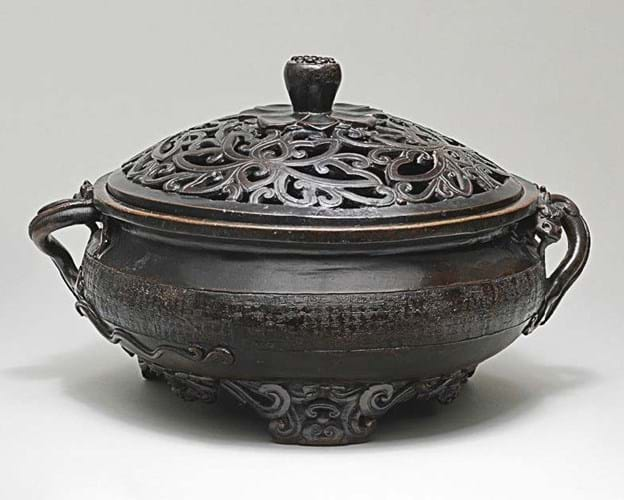
This large Ming Dynasty incense burner and cover has an estimate of £7000-10,000 at the Michael Goedhuis Brush and Bronze sale at Bonhams on May 18.
Goedhuis has no plans to retire – “I’m just changing the model” he says – but he is live to the fact that some of his generation of Asian art dealer have shut up shop. The sale Moving On: Roger Keverne took place across two dates at Bonhams in 2021, while last month, the remaining inventory of JJ Lally & Co went under the hammer at Christie’s New York, three years after the business closed.
Covid has not helped. Some chose to exit quicker than they might when forced to slow down in 2020.
One recent retirement is Richard Hoppé who spent 22 years in the trade specialising in Continental glass, ceramic tiles and perfume bottles. He now plans to return to his first profession of TV production. He disbanded the bulk of his remaining stock at Duke’s of Dorchester in its Art & Design Post 1880 sale on April 6.
Of the results he said: “The auction wasn’t a roaring success but about what I was expecting. Disbelief when some items sold way below hopes, surprise when other lots sold above.
“I expect I would have been disappointed if the sale had been business--related, but since it was more of a downsizing operation with a cheque at the end of it, I’m fine.”
Peaks and troughs
Peta Smyth’s retirement was marked at the Bonhams Collections sale of March 21.
Having dealt in antique textiles since the 1970s, a notice on her website now says: “After 45 years of dealing, I have decided to close my shop in Moreton Street in order to pursue a more leisurely life.” Indeed, when first approached by ATG, she was holidaying in Spain.
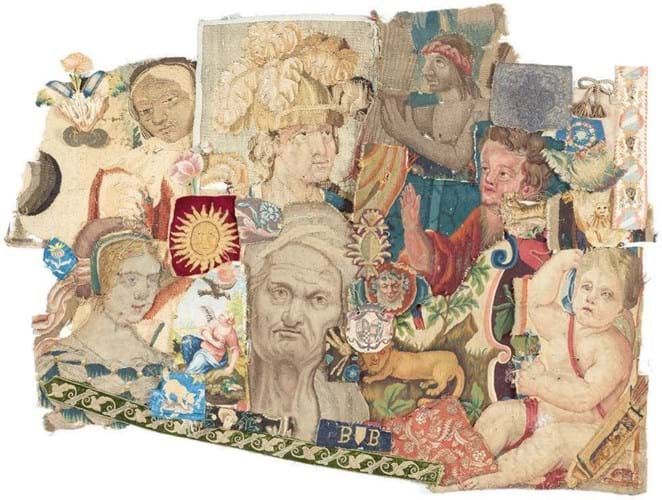
A collection of tapestry and needlework fragments from the wall of Peta Smyth’s office, £2600 at Bonhams.
However, before setting off for some sun, she had visited the Knightsbridge saleroom.
“I attended the auction with my daughters and prices fluctuated as they do in any auction. I was surprised that the large tapestries only reached the lower estimates, but this was more than made up for by the early tapestry on the front cover which fetched £50,000.”
This lot, a c.1550 large leaf tapestry fragment from the southern Netherlands, was the day’s best seller followed by a mythological Soho tapestry from the 17th century.
Smyth’s collection was mixed with the collection of Lord and Lady Flight and the contents of Chequers’ Attic. “We could not have been more different”, she adds.
As she searches for the right buyer for the shop there may be a little more business to be done.
“There have been interested parties, but nothing has been confirmed and I am keen to keep it as an antiques shop or art gallery – but in spite of the auction and a half-price sale there are still a lot of textiles around so I will need a few more months.”




